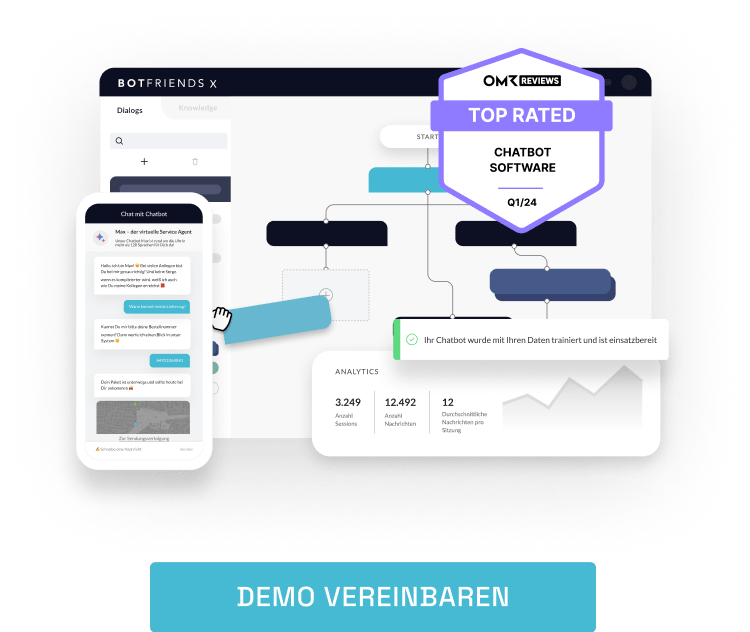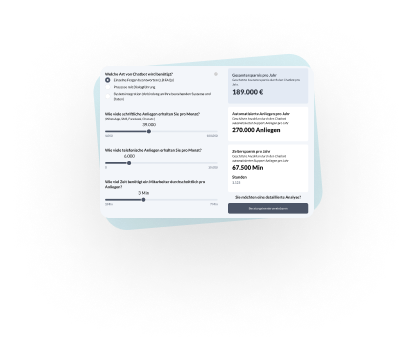With the increasing use of voicebots in customer service and telephony, text-to-speech (TTS) latency is becoming an increasingly critical factor. Users expect a real-time response and every millisecond counts - especially in telephone conversations where silence feels like failure.
To ensure the optimal performance of our phonebots at BOTfriends, we conducted a comprehensive benchmark in which we compared the TTS voices of Google Cloud and Microsoft Azure for German (de-DE). Our goal: to identify the fastest and most reliable voices for different message types.
Test setup
Each voice was tested in three use cases:
- Short message - 1 sentence
- Long message - 3-5 sentences
- Multiple messages - 3 consecutive short messages
Each test case was run three times per voice, and the average value (in milliseconds) was recorded to minimize anomalies. We analyzed both individual voices and voice types.
Summary of the test results
| Voice provider | Fastest voice type | Slowest voice type |
|---|---|---|
| Neural2 | Chirp | |
| Microsoft | Neural | DragonHD |
Best overall performance
- The voices from Google Neural2 and Microsoft Neural consistently delivered the lowest latency.
- Google's Neural2-G and Standard-D voices performed exceptionally well in all scenarios.
- Microsoft's KatjaNeural and KillianNeural were characterized by their responsiveness.
Most unsuitable for real-time use
- The Google Chirp3-HD voices had the highest latency of up to 3.5 seconds for long messages.
- Microsoft's DragonHDLatestNeural voices were similarly slow at 354 ms+ for short messages.
Detailed results
📊 Google TTS Voice Latency (ms)
| Voice type | Short message | Long message | Multiple messages |
|---|---|---|---|
| Standard | 159.96 | 468.83 | 153.60 |
| Neural | 🥇 101.17 | 🥇 133.50 | 🥇 82.67 |
| Wavenet | 324.04 | 951.12 | 210.37 |
| Chirp | 🚨 614.12 | 🚨 3436.52 | 🚨 525.82 |
Top performer:
- de-DE-Standard-D - 71.00 ms (short), 103.00 ms (long)
- de-DE-Neural2-H - 81.67 ms (short), 154.33 ms (long)
- de-DE-Neural2-G - 81.89 ms (multiple messages)
📊 Microsoft TTS Voice Latency (ms)
| Voice type | Short message | Long message | Multiple messages |
|---|---|---|---|
| Neural | 🥇 104.71 | 135.52 | 🥇 113.13 |
| MultilingualNeural | 120.00 | 153.34 | 163.00 |
| DragonHDLatestNeural | 🚨 356.00 | 403.84 | 🚨 342.61 |
Top performer:
- en-EN-GiselaNeural - 🥇 59.33 ms (short)
- en-EN-KatjaNeural - 64.00 ms (short), 83.33 ms (multiple)
- en-EN-KillianNeural - 80.00 ms (long)
Interpretation of the figures
Why latency is important:
- Lower latency = faster response time during calls.
- High TTS latency causes unpleasant pauses and impairs the user experience.
- Several shorter messages mimic the real conversation rhythm, which makes this metric very relevant.
Neural models are the ultimate:
- The neural voices of both providers outperform premium "HD" models such as Chirp and DragonHD in terms of speed.
- With telephone-based systems, fast response times outweigh the need for very natural-sounding speech.
Recommendations for voice bot developers
If you are developing voice bots for real-time interactions (e.g. customer service hotlines or IVRs), we strongly recommend that you do so:
✅ Use these voices for speed:
- Google en-EN-Neural2-G / H
- Google Standard-D / F
- Microsoft KatjaNeural / KillianNeural
❌ Avoid these voices for real-time use:
- Google Chirp3-HD-* Voices
- Microsoft DragonHDLatestNeural voices
These high latency voices can still be useful in non-interactive use cases or in cases where ultra-high quality is more important than speed.
Concluding thoughts
Our benchmarking clearly shows that not all TTS voices are created equal. With neural language models, both Google and Microsoft offer high-performance, low-latency options that are suitable for modern phone bots.
At BOTfriends, we strive to deliver fast, natural voice experiences - and tests like this ensure we're working with the best tools available.
Frequently asked questions
TTS (text-to-speech) latency is critical for phonebots in customer service, as it affects the response time of the bot. High latency times lead to unpleasant pauses in the conversation, which can be perceived by the user as hesitation or even errors on the part of the bot. This significantly impairs the user experience and can lead to frustration. Low latency, on the other hand, ensures a fluid, natural dialog that resembles human interaction. BOTfriends places great emphasis on optimized latency to ensure that phonebots respond quickly and efficiently to customer requests.
According to the BOTfriends TTS Latency Benchmark 2025, the neural voices of both providers deliver the lowest latency and are therefore ideal for real-time phonebot applications. At Google, these are in particular the 'Neural2' and 'Standard' voices, such as 'de-DE-Standard-D', 'de-DE-Neural2-G' and 'de-DE-Neural2-H'. On the Microsoft side, the 'Neural' voices, including 'de-DE-GiselaNeural', 'de-DE-KatjaNeural' and 'de-DE-KillianNeural', are characterized by their excellent responsiveness. The BOTfriends X platform is designed to fully support these powerful Google TTS and Microsoft TTS voices.
Yes, the BOTfriends benchmark identified voices that are unsuitable for real-time interactions with phonebots as they have significantly higher latency. These include Google's 'Chirp3-HD' voices and Microsoft's 'DragonHDLatestNeural' voices. Although these voices may offer very high sound quality in some cases, their slowness leads to delays that are perceived as annoying in interactive phone calls. However, for non-interactive use cases where quality is more important than speed, these voices can still be useful.
BOTfriends ensures the fast and natural speech output of its phonebots through continuous and comprehensive benchmarks of text-to-speech voices, such as the comparison between Google and Microsoft. The BOTfriends X platform is designed to enable the integration of the highest performing and lowest latency neural voices from both vendors. This ensures that phonebots can respond to customer service in real time, which is crucial for high user satisfaction. By supporting Google TTS and Microsoft TTS, the company can optimize the voice output to the requirements of each application.
Companies benefit from Phonebots with optimized TTS latency through a significantly improved customer experience. The fast and fluid responses ensure more natural interactions, making customers feel better understood and their concerns resolved more efficiently. This increases customer satisfaction and loyalty. Internally, the use of these phonebots leads to a considerable reduction in the workload of call center employees, as routine inquiries are processed automatically. This allows human agents to concentrate on more complex tasks, which increases the overall efficiency of customer service and leads to cost savings.

 AI Agent ROI Calculator
AI Agent ROI Calculator Free training: Chatbot crash course
Free training: Chatbot crash course Whitepaper: The acceptance of chatbots
Whitepaper: The acceptance of chatbots